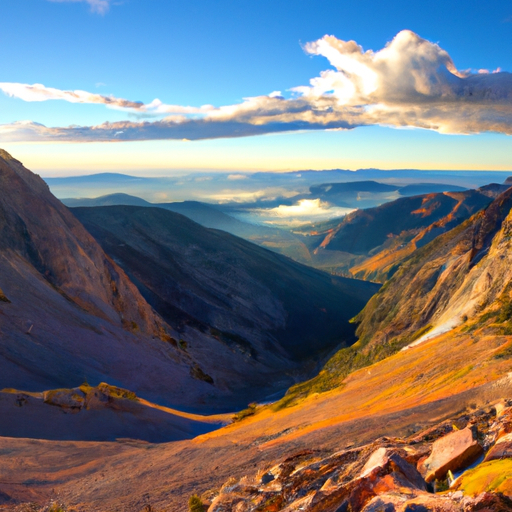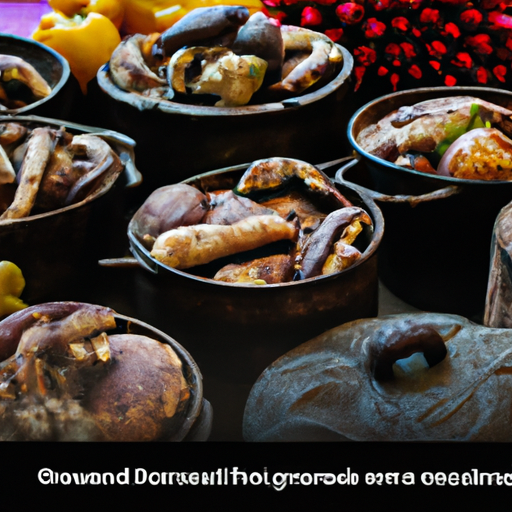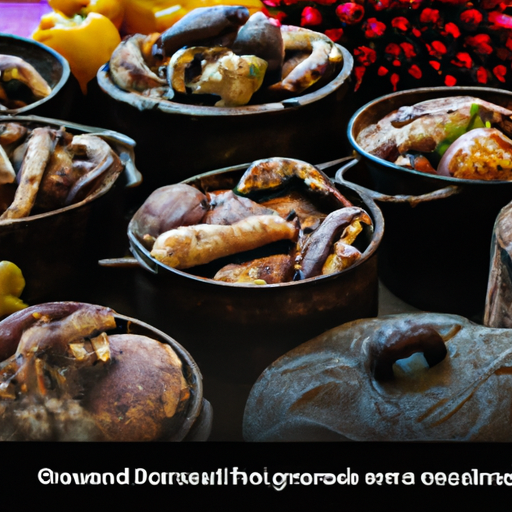Are you tired of your high altitude location messing with your cooking? Look no further! “Altitude Cooking Tips” is here to save the day. This handy product provides you with an altitude cooking chart that takes the guesswork out of adjusting your recipes. No more burnt cookies or undercooked casseroles – now you can confidently whip up delicious meals at any elevation. Say goodbye to culinary frustrations and hello to perfectly cooked dishes every time with “Altitude Cooking Tips”.
Choosing the Right Cookware and Utensils
Use of heavy-bottomed pots and pans
When it comes to cooking at high altitudes, using heavy-bottomed pots and pans is essential. The thin materials commonly found in cookware may not distribute heat evenly, leading to uneven cooking and burnt spots. In contrast, heavy-bottomed cookware ensures an even distribution of heat, allowing your food to cook more evenly. This is particularly important at higher altitudes, where the lower air pressure can affect cooking times. By investing in quality cookware with a thick and sturdy bottom, you can achieve better results in your high-altitude cooking adventures.
Avoid non-stick cookware
While non-stick cookware has its advantages in low-altitude cooking, it may not be the best choice for high-altitude cooking. Non-stick coatings can be more prone to damage and deterioration at higher altitudes due to the lower air pressure. This can result in the release of potentially harmful chemicals into your food. Additionally, the lower air pressure can cause the non-stick coating to lose its effectiveness, making it more likely for food to stick and burn. Opting for alternatives such as stainless steel or cast iron cookware is a safer and more reliable choice for high-altitude cooking.
Selecting sturdy utensils
Just like the cookware, the utensils you use also play a role in your high-altitude cooking experience. When selecting utensils, it’s important to choose sturdy options that can withstand the demands of high-altitude cooking. Flimsy utensils may warp or become damaged when exposed to higher temperatures or when stirring denser doughs and batters. Look for utensils made from heat-resistant materials such as silicone, stainless steel, or wood, as these will provide the necessary durability and functionality for your high-altitude culinary endeavors.
Understanding the Impact of Altitude on Cooking Time
Factors affecting cooking time at high altitude
Cooking time is greatly influenced by altitude due to the lower air pressure at higher elevations. At higher altitudes, the boiling point of water decreases, which affects the cooking process. The lower boiling point means that foods take longer to cook because the lower temperature cannot transfer heat as efficiently. Additionally, the decreased air pressure affects the rate of evaporation, potentially causing foods to dry out more quickly and altering their texture and flavor. Understanding these factors is crucial for adapting your cooking techniques and recipes to achieve delicious results at high altitudes.
Adjusting cooking time for different types of food
To account for the increased cooking time needed at high altitudes, it’s important to adjust your recipes accordingly. The general rule of thumb is to increase the cooking time by approximately 25% for every 1,000 feet above sea level. However, this may vary depending on the specific recipe and the type of food you are cooking. For example, foods that require longer cooking times, such as roasts or casseroles, may require a larger increase in cooking time compared to quick-cooking dishes like vegetables or stir-fries. It’s essential to monitor the cooking process closely and use a reliable cooking thermometer to ensure that your food reaches the desired doneness.
Managing Boiling Point and Water Evaporation
Effects of altitude on boiling point and water evaporation
Altitude has a significant impact on two crucial aspects of cooking with water: boiling point and water evaporation. At higher altitudes, the boiling point of water decreases, which means that it boils at a lower temperature. This can affect the cooking time of various dishes, as they might take longer to reach the desired level of doneness. Additionally, the lower air pressure at high altitudes causes water to evaporate more rapidly. This can lead to a drier cooking environment, potentially resulting in food drying out more quickly or sauces thickening too rapidly. Understanding these effects is key to successful high-altitude cooking.

Tips for cooking with boiling water at high altitude
To effectively manage boiling point and water evaporation at high altitudes, it’s important to make some adjustments to your cooking techniques. When boiling water, you may need to increase the cooking time slightly to compensate for the lower boiling point. Additionally, using a lid while boiling water can help retain heat and prevent excessive evaporation. For recipes that require simmering or reducing liquids, it may be necessary to adjust the heat lower and monitor the process more closely than at sea level. By making these small adaptations, you can ensure that your dishes turn out perfectly cooked and retain their desired moisture levels.
Dealing with Baking Challenges
Understanding the impact of altitude on baking
Baking at higher altitudes poses unique challenges due to the changes in air pressure and moisture levels. The lower air pressure affects the leavening process and can cause baked goods to rise more quickly and then collapse before being fully set. This can result in dense and sunken cakes, bread, or pastries. Additionally, high-altitude baking can lead to dryness due to increased moisture evaporation. Understanding these impacts is essential to overcome these challenges and achieve successful high-altitude baking.
Tips for successful high-altitude baking
To ensure successful baking at high altitudes, there are several tips and adjustments you can make. Firstly, reducing the leavening agents, such as baking powder or yeast, can help prevent the rapid rise and collapse of baked goods. Similarly, decreasing the amount of sugar in recipes can help retain moisture and improve texture. Increasing the oven temperature slightly can also aid in setting the structure of the baked goods more quickly. Additionally, it’s important to closely monitor the baking process and use skewers or cakes testers to ensure that the baked goods are cooked through. By making these adjustments and being attentive during the baking process, you can achieve delicious and well-risen treats even at high altitudes.
Making Adjustments for Leavening Agents
Understanding the challenges of using leavening agents at high altitude
Leavening agents, such as baking powder, baking soda, or yeast, play a crucial role in the texture and rising of baked goods. However, at higher altitudes, where the air pressure is lower, the leavening process can be affected. The lower air pressure allows gases to expand more rapidly, leading to a quicker rise in the batter or dough. This can result in baked goods that rise unevenly, collapse, or have a coarse texture. Understanding these challenges is essential for making the necessary adjustments when using leavening agents at high altitudes.
Tips for adjusting leavening agents in recipes
To ensure proper leavening in your baked goods at high altitudes, it’s important to make some adjustments to your recipes. Firstly, reducing the amount of leavening agents, such as baking powder or baking soda, can help balance the rapid rise caused by the lower air pressure. Additionally, adding a bit of acid, such as lemon juice or cream of tartar, can help regulate the leavening process. It’s also beneficial to mix the batter or dough gently to prevent excess air incorporation, which can contribute to an uneven rise. Experimentation and observation are key in finding the right balance of leavening agents for your high-altitude baking endeavors.
Managing Air Pressure and Rising Dough
Understanding how air pressure affects rising dough
When making bread or other yeast-based dough at high altitudes, air pressure plays a crucial role in the rising process. Due to the lower air pressure, the yeast activity can be more vigorous, causing the dough to rise more quickly and aggressively. This rapid rise can result in an overproofed dough, leading to a dense and collapsed final product. Understanding how air pressure affects rising dough is crucial for achieving light and airy bread at higher altitudes.

Tips for successful bread-making at high altitude
To successfully make bread at high altitudes, it’s important to make specific adjustments to your bread-making techniques. Firstly, reducing the amount of yeast in the recipe can help slow down the rise, allowing for proper fermentation and flavor development. Additionally, shorter proving times and a cooler environment for the dough to rise can help control the rate of fermentation. Punching down the dough gently at intervals during the rising process can also help release excess gases and prevent overproofing. By implementing these adjustments, you can achieve beautifully risen and flavorful bread even at high altitudes.
Preventing Dryness in Cooking and Baking
Moisture retention techniques in high-altitude cooking
Due to the lower air pressure and increased moisture evaporation at high altitudes, dryness can be a common issue in both cooking and baking. To prevent dryness, it’s important to utilize techniques that help retain moisture throughout the cooking process. One effective method is to marinate meats or vegetables before cooking to enhance their moisture content. Additionally, basting ingredients with liquids such as broths, sauces, or even melted butter can help keep them moist and flavorful. Another useful technique is to utilize steam while cooking by adding water or broth to the cooking vessel or using a steamer basket. These moisture retention techniques can make a significant difference in the final result of your high-altitude culinary creations.
Tips for avoiding dryness in high-altitude baking
In high-altitude baking, dryness can be a common problem due to the increased moisture evaporation. To mitigate this issue and achieve moist and tender baked goods, there are several tips you can follow. Firstly, increasing the liquid content in the recipe, such as milk, yogurt, or buttermilk, can help add moisture to the batter or dough. Adding extra fat, such as butter or oil, can also contribute to moisture retention. It’s essential to monitor the baking process closely to avoid overbaking, as this can lead to dry and crumbly results. Finally, properly storing the baked goods in airtight containers or wrapping them tightly in plastic wrap can help maintain their moisture for longer periods. By implementing these strategies, you can successfully combat dryness in your high-altitude baking endeavors.
Dealing with Flavor Changes at Higher Altitudes
Understanding how altitude affects flavor perception
Altitude can have a noticeable impact on flavor perception when it comes to high-altitude cooking. The lower air pressure affects aroma molecules, making them volatile and more prone to escaping into the atmosphere. This can lead to diminished flavor intensity and complexity in cooked dishes. Additionally, the drier cooking environment at high altitudes can affect the sensory perception of flavors. Understanding how altitude affects flavor perception is important for adjusting your cooking techniques to enhance flavors and create more delicious meals.
Tips for enhancing flavors in high-altitude cooking
To enhance flavors in high-altitude cooking, there are several tips you can consider. Firstly, increasing the use of herbs, spices, and seasonings can help compensate for the potential flavor loss. Their aromatic compounds can contribute to stronger and more pronounced flavors in your dishes. Additionally, utilizing umami-rich ingredients such as mushrooms, soy sauce, or aged cheeses can add depth and complexity to your recipes. Experimenting with different cooking techniques, such as roasting or caramelizing ingredients, can also intensify flavors. Lastly, tasting and adjusting the seasonings throughout the cooking process is key to achieving a well-balanced and flavorful high-altitude dish.
Adjusting Recipes for High-Altitude Cooking
General guidelines for adjusting recipes at high altitude
Adjusting recipes for high-altitude cooking requires understanding and accounting for the impacts of altitude on various cooking factors. As a general guideline, increasing the cooking time and decreasing the baking temperature is recommended. Additionally, reducing the amount of leavening agents, sugar, and liquids in recipes can help achieve better results. It is crucial to monitor the cooking process closely, make adjustments as needed, and rely on reliable kitchen tools such as thermometers or timers for accurate measurements and timing.
Specific adjustments for different types of recipes
Different types of recipes may require specific adjustments to achieve optimal results at high altitudes. For example, in cake recipes, reducing the amount of sugar and leavening agents while increasing the liquid content can help maintain moisture and prevent an overly light and collapsed texture. In cookie recipes, reducing the baking temperature and increasing the baking time can prevent excessive spreading and browning. For recipes involving stovetop cooking, adjusting the heat lower and adding extra liquids can compensate for the increased evaporation. It’s important to consult altitude-specific recipes or resources for more precise adjustments depending on the type of dish you are preparing.
Additional Tips and Tricks for Altitude Cooking
Using an oven thermometer for accurate temperature control
To ensure accurate temperature control while cooking or baking at high altitudes, it’s highly recommended to use an oven thermometer. Ovens can often have temperature variations and may not accurately reflect the set temperature. By placing an oven thermometer inside the oven, you can monitor and adjust the temperature accordingly to achieve the desired cooking results. This is particularly important at higher altitudes, where precise temperature control is essential for successful culinary creations.
Importance of preheating the oven
Preheating your oven is a crucial step in high-altitude cooking. By preheating, you ensure that the oven is at the desired temperature when you place your food inside. This is especially important at high altitudes, where the lower air pressure affects cooking times. By preheating the oven, you ensure that your food cooks evenly and consistently. It also helps with better browning and texture development in baked goods. Always follow the recipe’s instructions for preheating time and temperature to ensure the best possible outcome.
Accounting for altitude in pressure cooking
Pressure cooking is a popular cooking method known for its efficiency and ability to cook food quickly. However, at high altitudes, pressure cooking can be affected due to the lower boiling point of water. To compensate for this, it’s important to increase the cooking time when pressure cooking at higher elevations. Follow the manufacturer’s instructions for adjusting the cooking time based on altitude, as different pressure cookers may have specific recommendations. By making these adjustments, you can continue to enjoy the benefits of pressure cooking while accounting for the effects of altitude.
